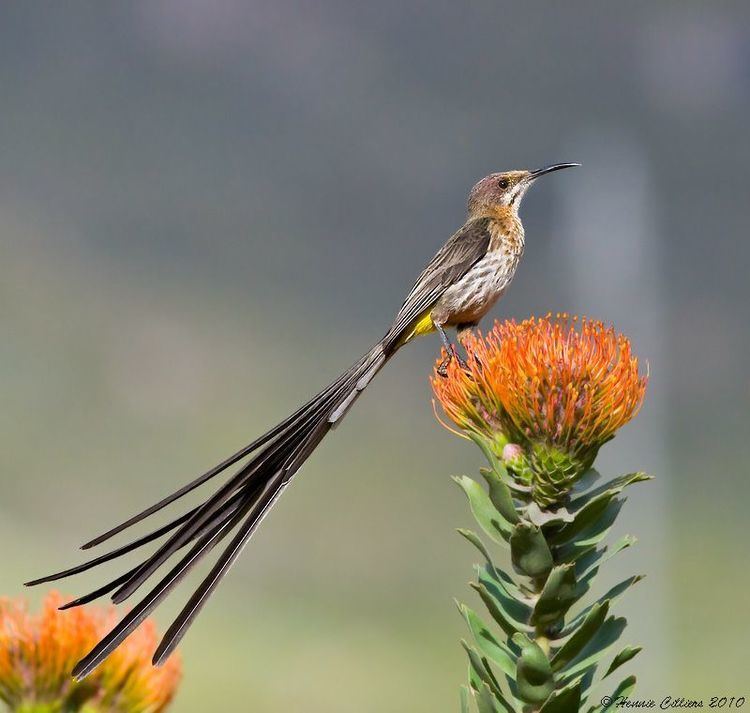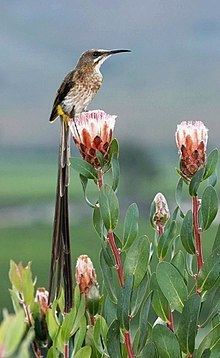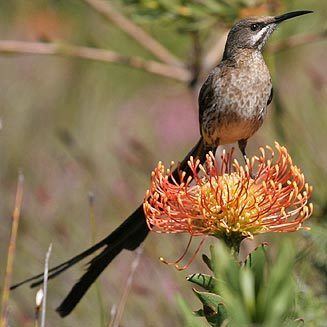Scientific name Promerops Higher classification Promeropidae Order Passerine | Suborder Passeri Phylum Chordata Rank Genus | |
 | ||
Family PromeropidaeVigors, 1825 Lower classifications | ||
Cape sugarbird kirstenbosch south africa 22nd november 2012
The sugarbirds are a small genus, Promerops, and family, Promeropidae, of passerine birds which are restricted to southern Africa. In general appearance as well as habits they resemble large long-tailed sunbirds, but are possibly more closely related to the Australian honeyeaters. They have brownish plumage, the long downcurved bill typical of passerine nectar feeders, and long tail feathers.
Contents
- Cape sugarbird kirstenbosch south africa 22nd november 2012
- Sugarbird divatbemutat 2013 2014 es szi t li kollekci
- Taxonomy
- Distribution and habitat
- Description
- Behaviour
- Species
- References

Sugarbird divatbemutat 2013 2014 es szi t li kollekci
Taxonomy

The relationships of the sugarbirds have been the source of considerable debate. They were first treated as a far-flung member of the honeyeater family, which is otherwise restricted to the Australasian region. Looking at egg white proteins in the 1970s Sibley and Ahlquist mistakenly placed them with the starlings (the samples used were actually those of sunbirds). They have also been linked to the thrushes (Turdidae) and the sunbirds. Molecular studies find support for few close relatives, and they are treated as a family at present, although it now is usually determined they form a clade with three enigmatic species. These species, from the mountains of East Africa, were formerly placed in the large taxon that includes the Old World babblers. Recent studies indicate the family to be monotypic.
Distribution and habitat

The Gurney's sugarbird is found from Zimbabwe southwards, except the extreme south of South Africa, where it is replaced by the Cape sugarbird in the Cape provinces of South Africa. It has at times been considered conspecific with Gurney's. The distribution of the Gurney's sugarbird is disjunct, and currently there are two accepted subspecies, one in the north and one further south.

Sugarbirds are dependent on Protea and are found in protea scrub. The Cape sugarbird is found in fynbos and has also moved into gardens and nurseries.
Description

The two sugarbird species are medium-sized passerines that weigh between 26 and 46 g (0.92 and 1.62 oz) and are 23 to 44 cm (9.1–17.3 in) in length. Between 15 and 38 cm (5.9 and 15.0 in) of that length is in their massive elongated tails, the tails of the Cape sugarbird being overall longer than those of the Gurney's sugarbird. In both species the tail of the male is longer than the female, although the difference is more pronounced in the Cape sugarbird. In overall body size the males are slightly larger and heavier than the females. Both species have long and slender bills that are slightly curved, and again the females have a slightly shorter bill, leading to differences in feeding niches. The skull and tongue morphology of the sugarbirds is very similar to that of the honeyeaters, the result of convergent evolution. The tongue is long and protrusible, and is tubular and frilled at the end.
Behaviour
Nectar from the inflorescences of the Protea provide most of the energy these species require, and they are considered significant pollinators of the genus. The birds' diet is supplemented by insects attracted to the inflorescences. Studies of the diets of sugarbirds found that bees in the family Apidae and flies formed a large part of the diet and that the insects were obtained by hawking.
The breeding behaviour and nesting habits of the two species of sugarbird are very similar. Sugarbirds are monogamous, and male sugarbirds defend territories during the breeding season. Females lay two eggs in a nest in a fork of a tree.
